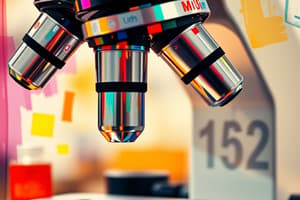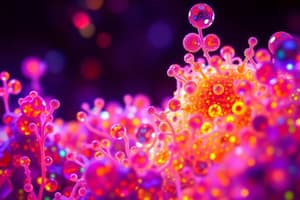Podcast
Questions and Answers
What is the primary focus of microscopy in the context of animal science?
What is the primary focus of microscopy in the context of animal science?
- Analyzing animal behavior
- Observing macroscopic organisms
- Studying microscopic structures (correct)
- Measuring body temperatures
Which of the following techniques is primarily used in microscopy for enhancing image resolution?
Which of the following techniques is primarily used in microscopy for enhancing image resolution?
- Genetic modification
- Behavioral observation
- Mathematical modeling
- Staining (correct)
Which type of microscopy would most likely be used to explore the internal structures of cells?
Which type of microscopy would most likely be used to explore the internal structures of cells?
- Darkfield microscopy
- Transmission electron microscopy (correct)
- Fluorescence microscopy
- Brightfield microscopy
In microscopy, what is the purpose of using high magnification?
In microscopy, what is the purpose of using high magnification?
Which of the following is a common limitation of microscopy techniques?
Which of the following is a common limitation of microscopy techniques?
What is the primary purpose of using microscopes in the technical field?
What is the primary purpose of using microscopes in the technical field?
Which of the following objects would most likely require a microscope for observation?
Which of the following objects would most likely require a microscope for observation?
In which scenarios are microscopes typically utilized?
In which scenarios are microscopes typically utilized?
What kind of samples can benefit from microscopic examination?
What kind of samples can benefit from microscopic examination?
What advantage does a microscope provide over regular eyesight?
What advantage does a microscope provide over regular eyesight?
What is the purpose of a scale bar in measuring specimens?
What is the purpose of a scale bar in measuring specimens?
Which of the following applications can be used to measure the size of photographed specimens using a scale bar?
Which of the following applications can be used to measure the size of photographed specimens using a scale bar?
What is a blood smear?
What is a blood smear?
In which scenario would a micrometer slide be particularly useful?
In which scenario would a micrometer slide be particularly useful?
Why might standard photo editing software not be sufficient for precise specimen measurement?
Why might standard photo editing software not be sufficient for precise specimen measurement?
What is the primary function of red blood cells (RBCs) in the human body?
What is the primary function of red blood cells (RBCs) in the human body?
Which component of blood is essential for the clotting process?
Which component of blood is essential for the clotting process?
Which step in blood smear preparation involves the use of an anticoagulant?
Which step in blood smear preparation involves the use of an anticoagulant?
What technique is suggested for preparing a blood smear on a slide?
What technique is suggested for preparing a blood smear on a slide?
What is necessary to do within one hour of collecting blood to avoid distortion of cells?
What is necessary to do within one hour of collecting blood to avoid distortion of cells?
What type of microscope uses one ocular lens?
What type of microscope uses one ocular lens?
Which part of the compound light microscope is responsible for adjusting the focus?
Which part of the compound light microscope is responsible for adjusting the focus?
What type of image does a scanning electron microscope (SEM) create?
What type of image does a scanning electron microscope (SEM) create?
What is the purpose of using oil with the oil immersion lens?
What is the purpose of using oil with the oil immersion lens?
What does the numerical aperture (NA) measure in a microscope?
What does the numerical aperture (NA) measure in a microscope?
How does the transmission electron microscope (TEM) visualize specimens?
How does the transmission electron microscope (TEM) visualize specimens?
What is the maximum magnification power of the oil immersion lens in a compound light microscope?
What is the maximum magnification power of the oil immersion lens in a compound light microscope?
Which component of the light microscope can be adjusted to control the amount of light passing through the specimen?
Which component of the light microscope can be adjusted to control the amount of light passing through the specimen?
What does the term 'working distance' refer to in microscopy?
What does the term 'working distance' refer to in microscopy?
What is the resolution power of a microscope?
What is the resolution power of a microscope?
Which type of lens is used in the scanning electron microscope?
Which type of lens is used in the scanning electron microscope?
What does the formula NA = n sinθ represent in microscopy?
What does the formula NA = n sinθ represent in microscopy?
Which microscopes typically use stages for slide manipulation?
Which microscopes typically use stages for slide manipulation?
What happens to the lens's numerical aperture as the angle of light increases?
What happens to the lens's numerical aperture as the angle of light increases?
Flashcards are hidden until you start studying
Study Notes
Microscopy
- Microscopy is the technical field that uses microscopes to view samples and objects that cannot be seen with the unaided eye.
- Microscopes can be classified by the number of lenses they have, such as monocular, biocular, or simple light microscopes.
- Compound light microscopes are the most commonly used microscopes.
Compound Light Microscope Parts
- Optical System:
- Ocular lens (eyepiece)
- Objective lens
- Nosepiece
- Head
- Eye piece tube
- Mechanical System:
- Arm
- Mechanical stage
- Aperture
- Diaphragm
- Condenser
- Coarse adjustment
- Fine adjustment
- Stage controls
- Base
- Illuminator (light)
- Light switch
- Brightness adjustment
Compound Light Microscope Lenses
- Scanning lens
- Low power lens
- High power lens
- Oil immersion lens
Sliding Ruler
- Used for adjusting and saving the location of a slide on the microscope stage.
- Has X and Y axes.
Electron Microscopes
- Scanning electron microscope (SEM): Creates a 3D image by detecting reflected electrons.
- Transmission electron microscope (TEM): Creates a 2D image using electrons that pass through the sample.
Scanning Electron Microscope (SEM) vs. Transmission Electron Microscope (TEM)
- Source of Illumination: Electrons used for image formation in both types of microscopes.
- Visualized Cells: SEM: Specimens coated with gold, electrons reflected back to give an image of the specimen's surface. TEM: Thin sections of the specimen are used, electrons pass through the section to give an image of the internal structure of the specimen.
- Images: SEM: 3D. TEM: 2D.
- Lenses: SEM: One electrostatic lens with few electromagnetic lenses. TEM: One electrostatic lens with few electromagnetic lenses.
- Medium: Vacuum for both.
Concepts
- Resolution power: The ability of a microscope to distinguish the details of a sample.
- Magnification power: The enlargement of images up to 1000 times their original size.
- Working distance: The vertical distance between the front surface of the lens and the surface of the coverslip on the specimen.
- Numerical aperture (NA): The ability of an objective lens to collect light. Formula: NA = n sinθ.
- n: Refractive index of the medium
- θ: Angle of light collected by the objective lens
Formula for Resolution and Magnification
- Resolution (R): R = 0.6λ / NA.
- λ: Wavelength of light (approximately 0.527)
- NA: Numerical aperture
- Magnification (M): M = (Power of eyepiece) × (Power of objective lens)
- Total Magnification: (Power of eyepiece) × (Power of objective lens)
Example
- If the maximum NA for an oil immersion lens is 1.5, the maximum possible resolution of the light microscope can be calculated using the resolution formula.
- Scale bars are used to measure the size of photographed specimens within different applications.
Blood Film (Blood Smear)
- A blood smear is a blood test used to examine abnormalities in blood cells.
- Three components of human blood:
- Red blood corpuscles or cells (RBCs): Carry oxygen throughout the human body.
- White blood cells (WBCs): Help the human body fight infections.
- Platelets (PLTs): Important for blood clotting.
Steps of Blood Smear Preparation
- Preparation of blood smear: Collection of peripheral blood, put in EDTA (anticoagulant) or finger stick blood directly onto a slide.
- Fixation of blood smear: This involves using a fixative like methanol to preserve the cells' morphology.
- Staining of blood smear: This step uses different stains (e.g., Romanowsky stain) to differentiate between blood cell types.
Blood Smear Preparation Equipment
- Spreaders
- Clean slides
- Capillary tubes
- Micropipette
Blood Smear Preparation Steps
- Place a blood drop (2mm diameter) approximately an inch from the frosted area of the slide.
- Place the slide on a flat surface and hold the narrow side of the non-frosted edge between your thumb and forefinger.
- Place the smooth clean edge of a second slide (spreader slide) just in front of the blood drop.
- Allow the blood to spread almost to the edges of the spreader slide.
- Push the spread forward with one light, smooth, and fluid motion.
Studying That Suits You
Use AI to generate personalized quizzes and flashcards to suit your learning preferences.




